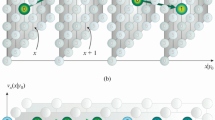Abstract
We present a novel geometric approach for solving the stereo problem for an arbitrary number of images (greater than or equal to 2). It is based upon the definition of a variational principle that must be satisfied by the surfaces of the objects in the scene and their images. The Euler-Lagrange equations which are deduced from the variational principle provide a set of PDE's which are used to deform an initial set of surfaces which then move towards the objects to be detected. The level set implementation of these PDE's potentially provides an efficient and robust way of achieving the surface evolution and to deal automatically with changes in the surface topology during the deformation, i.e. to deal with multiple objects. Results of a two dimensional implementation of our theory are presented on synthetic and real images.
This work was partially supported by the Esprit grant Improofs, Nr. 23515, LTR domain.
Preview
Unable to display preview. Download preview PDF.
Similar content being viewed by others
References
Boston, MA, June 1995. IEEE Computer Society Press.
V. Caselles, R. Kimmel, and G. Sapiro. Geodesic active contours. In Proceedings of the 5th International Conference on Computer Vision [1], pages 694–699.
V. Caselles, R. Kimmel, G. Sapiro, and C. Sbert. 3d active contours. In M-O. Berger, R. Deriche, I. Herlin, J. Jaffre, and J-M. Morel, editors, Images, Wavelets and PDEs, volume 219 of Lecture Notes in Control and Information Sciences, pages 43–49. Springer, June 1996.
David L. Chopp. Computing minimal surfaces via level set curvature flow. Journal of Computational Physics, 106:77–91, 1993.
Rachid Deriche, Stéphane Bouvin, and Olivier Faugeras. A level-set approach for stereo. In Fisrt Annual Symposium on Enabling Technologies for Law Enforcement and Security — SPIE Conference 2942: Investigative Image Processing., Boston, Massachusetts USA, November 1996.
Frédéric Devernay and Olivier Faugeras. Computing differential properties of 3-D shapes from stereoscopic images without 3-D models. In Proceedings of the International Conference on Computer Vision and Pattern Recognition, pages 208–213, Seattle, WA, June 1994. IEEE.
Olivier Faugeras. Three-Dimensional Computer Vision: a Geometric Viewpoint. MIT Press, 1993.
Olivier Faugeras and Renaud Keriven. Variational principles, surface evolution, pde's, level set methods and the stereo problem. Technical Report 3021, INRIA, November 1996.
L.M.J. Florack. The syntactical structure of scalar images. PhD thesis, Utrecht University, 1993.
M. Gage and R.S. Hamilton. The heat equation shrinking convex plane curves. J. of Differential Geometry, 23:69–96, 1986.
M. Grayson. The heat equation shrinks embedded plane curves to round points. J. of Differential Geometry, 26:285–314, 1987.
W.E.L. Grimson. From Images to Surfaces. MIT Press: Cambridge, 1981.
H. L. F. von Helmholtz. Treatise on Physiological Optics. New York: Dover, 1925. Translated by J.P. Southall.
Berthold Klaus Paul Horn. Robot Vision. MIT Press, 1986.
Bela Julesz. Foundations of Cyclopean perception. The University of Chicago Press, Chicago and London, 1971.
M. Kass, A. Witkin, and D. Terzopoulos. SNAKES: Active contour models. The International Journal of Computer Vision, 1:321–332, January 1988.
S. Kichenassamy, A. Kumar, P. Olver, A. Tannenbaum, and A. Yezzi. Gradient flows and geometric active contour models. In Proc. Fifth International Conference on Computer Vision [1].
S. Osher and J. Sethian. Fronts propagating with curvature dependent speed: algorithms based on the Hamilton-Jacobi formulation. Journal of Computational Physics, 79:12–49, 1988.
L. Robert and R. Deriche. Dense depth map reconstruction: A minimization and regularization approach which preserves discontinuities. In Bernard Buxton, editor, Proceedings of the 4th European Conference on Computer Vision, Cambridge, UK, April 1996.
L. Robert, R. Deriche, and O.D. Faugeras. Dense depth recovery from stereo images. In Proceedings of the European Conference on Artificial Intelligence, pages 821–823, Vienna, Austria, August 1992.
Guillermo Sapiro and Allen Tannenbaum. Affine Invariant Scale Space. The International Journal of Computer Vision, 11(1):25–44, August 1993.
J. A. Sethian. Level Set Methods. Cambridge University Press, 1996.
J.A. Sethian. Numerical algorithms for propagating interfaces: Hamilton-jacobi equations and conservation laws. Journal of Differential Geometry, 31:131–161, 1990.
J.A. Sethian. Theory, algorithms, and applications of level set methods for propagating interfaces. Technical Report PAM-651, Center for Pure and Applied Mathematics, University of California, Berkeley, August 1995. To appear Acta Numerica.
Author information
Authors and Affiliations
Editor information
Rights and permissions
Copyright information
© 1997 Springer-Verlag Berlin Heidelberg
About this paper
Cite this paper
Faugeras, O., Keriven, R. (1997). Level set methods and the stereo problem. In: ter Haar Romeny, B., Florack, L., Koenderink, J., Viergever, M. (eds) Scale-Space Theory in Computer Vision. Scale-Space 1997. Lecture Notes in Computer Science, vol 1252. Springer, Berlin, Heidelberg. https://doi.org/10.1007/3-540-63167-4_57
Download citation
DOI: https://doi.org/10.1007/3-540-63167-4_57
Published:
Publisher Name: Springer, Berlin, Heidelberg
Print ISBN: 978-3-540-63167-5
Online ISBN: 978-3-540-69196-9
eBook Packages: Springer Book Archive




